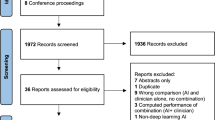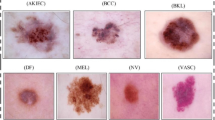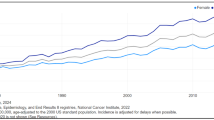Abstract
Purpose
To review recent developments in artificial intelligence for skin cancer diagnosis.
Recent Findings
Major breakthroughs in recent years are likely related to advancements in utilization of convolutional neural networks (CNNs) for dermatologic image analysis, especially dermoscopy. Recent studies have shown that CNN-based approaches perform as well as or even better than human raters in diagnosing close-up and dermoscopic images of skin lesions in a simulated static environment. Several limitations for the development of AI include the need for large data pipelines and ground truth diagnoses, lack of metadata, and lack of rigorous widely accepted standards.
Summary
Despite recent breakthroughs, adoption of AI in clinical settings for dermatology is in early stages. Close collaboration between researchers and clinicians may provide the opportunity to investigate implementation of AI in clinical settings to provide real benefit for both clinicians and patients.
Similar content being viewed by others
References
Papers of particular interest, published recently, have been highlighted as: •• Of major importance
American Cancer Soceity, Cancer facts & figures 2019 [database on the Internet] 2019. Available from: https://www.cancer.org/content/dam/cancer-org/research/cancer-facts-and-statistics/annual-cancer-facts-and-figures/2019/cancer-facts-and-figures-2019.pdf. Accessed:
Murzaku EC, Hayan S, Rao BK. Methods and rates of dermoscopy usage: a cross-sectional survey of US dermatologists stratified by years in practice. J Am Acad Dermatol. 2014;71(2):393–5. https://doi.org/10.1016/j.jaad.2014.03.048.
Dinnes J, Deeks JJ, Chuchu N, Ferrante di Ruffano L, Matin RN, Thomson DR et al. Dermoscopy, with and without visual inspection, for diagnosing melanoma in adults. The Cochrane database of systematic reviews. 2018;12:Cd011902. doi:https://doi.org/10.1002/14651858.CD011902.pub2.
Reiter O, Mimouni I, Gdalevich M, Marghoob AA, Levi A, Hodak E, et al. The diagnostic accuracy of dermoscopy for basal cell carcinoma: a systematic review and meta-analysis. J Am Acad Dermatol. 2018;80:1380–8. https://doi.org/10.1016/j.jaad.2018.12.026.
Dinnes J, Deeks JJ, Saleh D, Chuchu N, Bayliss SE, Patel L et al. Reflectance confocal microscopy for diagnosing cutaneous melanoma in adults. The Cochrane database of systematic reviews. 2018;12:Cd013190. doi:https://doi.org/10.1002/14651858.Cd013190.
Ferrante di Ruffano L, Dinnes J, Deeks JJ, Chuchu N, Bayliss SE, Davenport C et al. Optical coherence tomography for diagnosing skin cancer in adults. The Cochrane database of systematic reviews. 2018;12:Cd013189. doi:https://doi.org/10.1002/14651858.Cd013189.
Turing am. i.—Computing machinery and Intelligence. mind. 1950;LIX(236):433–460. doi:https://doi.org/10.1093/mind/LIX.236.433 %J Mind.
Samuel AL. Some studies in machine learning using the game of checkers %J IBM. J Res Dev. 1959;3(3):210–29. https://doi.org/10.1147/rd.33.0210.
Krizhevsky A, Sutskever I, Hinton GE. ImageNet classification with deep convolutional neural networks. Proceedings of the 25th international conference on neural information processing systems - volume 1; Lake Tahoe, Nevada 2999257: Curran Associates Inc; 2012. p. 1097–105.
Srivastava N, Hinton G, Krizhevsky A, Sutskever I, Salakhutdinov R. Dropout: a simple way to prevent neural networks from overfitting %J J. Mach Learn Res. 2014;15(1):1929–58.
Brinker TJ, Hekler A, Utikal JS, Grabe N, Schadendorf D, Klode J, et al. Skin cancer classification using convolutional neural networks: systematic review. J Med Internet Res. 2018;20(10):e11936. https://doi.org/10.2196/11936.
Gabriella Fabbrocini GB, Di Leo G, Liguori C, Paolillo A, Pietrosanto A, Sommella P, et al. Epiluminescence image processing for melanocytic skin lesion diagnosis based on 7-point check-list: a preliminary discussion on three parameters. Open Dermatol J. 2010;4(1):6.
Binder M, Steiner A, Schwarz M, Knollmayer S, Wolff K, Pehamberger H. Application of an artificial neural network in epiluminescence microscopy pattern analysis of pigmented skin lesions: a pilot study. Br J Dermatol. 1994;130(4):460–5.
Olga Russakovsky JD, Hao S, Krause J, Satheesh S, Ma S, Huang Z, et al. ImageNet large scale visual recognition challenge. Int J Comput Vis. 2015;115(3):211–52.
Weber P, Tschandl P, Sinz C, Kittler H. Dermatoscopy of neoplastic skin lesions: recent advances, updates, and revisions. Curr Treat Options in Oncol. 2018;19(11):56. https://doi.org/10.1007/s11864-018-0573-6.
•• Esteva A, Kuprel B, Novoa RA, Ko J, Swetter SM, Blau HM, et al. Dermatologist-level classification of skin cancer with deep neural networks. Nature. 2017;542(7639):115–8 doi:10.1038/nature21056. This is a landmark study that started the current trend of using CNNs for dermatologic image classification.
•• Han SS, Kim MS, Lim W, Park GH, Park I, Chang SE. Classification of the clinical images for benign and malignant cutaneous tumors using a deep learning algorithm. J Invest Dermatol. 2018;138(7):1529–38. https://doi.org/10.1016/j.jid.2018.01.028 This is the second landmark study that showed the ability of CNNs to differentiate between multiple lesion types.
Tschandl P, Rosendahl C, Akay BN, Argenziano G, Blum A, Braun RP, et al. Expert-level diagnosis of nonpigmented skin cancer by combined convolutional neural networks. JAMA Dermatol. 2019;155(1):58–65. https://doi.org/10.1001/jamadermatol.2018.4378.
Ferrante di Ruffano L, Takwoingi Y, Dinnes J, Chuchu N, Bayliss SE, Davenport C, et al. Computer-assisted diagnosis techniques (dermoscopy and spectroscopy-based) for diagnosing skin cancer in adults. Cochrane Database Syst Rev. 2018. https://doi.org/10.1002/14651858.Cd013186.
Marka A, Carter JB, Toto E, Hassanpour S. Automated detection of nonmelanoma skin cancer using digital images: a systematic review. BMC Med Imaging. 2019;19(1):21. https://doi.org/10.1186/s12880-019-0307-7.
Haenssle HA, Fink C, Schneiderbauer R, Toberer F, Buhl T, Blum A, et al. Man against machine: diagnostic performance of a deep learning convolutional neural network for dermoscopic melanoma recognition in comparison to 58 dermatologists. Ann Oncol. 2018;29(8):1836–42. https://doi.org/10.1093/annonc/mdy166.
Brinker TJ, Hekler A, Enk AH, Klode J, Hauschild A, Berking C, et al. A convolutional neural network trained with dermoscopic images performed on par with 145 dermatologists in a clinical melanoma image classification task. Eur J Cancer. 2019;111:148–54. https://doi.org/10.1016/j.ejca.2019.02.005.
ISIC ARCHIVE. https://www.isic-archive.com.
•• Marchetti MA, Codella NCF, Dusza SW, Gutman DA, Helba B, Kalloo A, et al. Results of the 2016 International Skin Imaging Collaboration International Symposium on Biomedical Imaging challenge: comparison of the accuracy of computer algorithms to dermatologists for the diagnosis of melanoma from dermoscopic images. J Am Acad Dermatol. 2018;78(2):270–7 e1. https://doi.org/10.1016/j.jaad.2017.08.016 This is the first ISIC publication, where for the first time, AI developers were invited to use a ML challenge. It was open for everyone to participate and images were provided for free.
Gutman D, Codella, N.C., Celebi, M.E., Helba, B., Marchetti, M.A., Mishra, N.K., & Halpern, A. . Skin lesion analysis toward melanoma detection: a challenge at the 2017 International symposium on biomedical imaging (ISBI), hosted by the international skin imaging collaboration (ISIC). IEEE 15th international symposium on biomedical imaging (ISBI 2018), 168–172. 2018.
Tschandl P, Rosendahl C, Kittler H. The HAM10000 dataset: a large collection of multi-source dermatoscopic images of common pigmented skin lesions. 2018.
Yap J, Yolland W, Tschandl P. Multimodal skin lesion classification using deep learning. Exp Dermatol. 2018;27(11):1261–7. https://doi.org/10.1111/exd.13777.
Roffman D, Hart G, Girardi M, Ko CJ, Deng J. Predicting non-melanoma skin cancer via a multi-parameterized artificial neural network. Sci Rep. 2018;8(1):1701. https://doi.org/10.1038/s41598-018-19907-9.
Chuchu N, Takwoingi Y, Dinnes J, Matin RN, Bassett O, Moreau JF, et al. Smartphone applications for triaging adults with skin lesions that are suspicious for melanoma. Cochrane Database Syst Rev. 2018. https://doi.org/10.1002/14651858.Cd013192.
Marvdashti T, Duan L, Aasi SZ, Tang JY, Ellerbee Bowden AK. Classification of basal cell carcinoma in human skin using machine learning and quantitative features captured by polarization sensitive optical coherence tomography. Biomed Opt Express. 2016;7(9):3721–35. https://doi.org/10.1364/BOE.7.003721.
Bozkurt A, Kose K, Alessi-Fox C, Gill M, Dy J, Brooks D et al. A multiresolution convolutional neural network with partial label training for annotating reflectance confocal microscopy images of skin: 21st international conference, Granada, Spain, September 16–20 2018, Proceedings, Part II. 2018. p. 292–299.
Bozkurt A, Kose K, Alessi-Fox C, Dy JG, Brooks DH, Rajadhyaksha M. Unsupervised delineation of stratum corneum using reflectance confocal microscopy and spectral clustering. Skin Res Technol : Off J Int Soc Bioeng Skin (ISBS) [and] Int Soc Digital Imaging of Skin (ISDIS) [and] Int Soc Skin Imaging (ISSI) 2017;23(2):176–185. doi:https://doi.org/10.1111/srt.12316.
Kurugol S, Kose K, Park B, Dy JG, Brooks DH, Rajadhyaksha M. Automated delineation of dermal-epidermal junction in reflectance confocal microscopy image stacks of human skin. J Invest Dermatol. 2015;135(3):710–7. https://doi.org/10.1038/jid.2014.379.
Bozkurt A, Kose K, Coll-Font J, Alessi-Fox C, Brooks DH, Dy JG et al. Delineation of skin strata in reflectance confocal microscopy images using recurrent convolutional networks with Toeplitz Attention arXiv e-prints 2017.
Hosking AM, Coakley BJ, Chang D, Talebi-Liasi F, Lish S, Lee SW, et al. Hyperspectral imaging in automated digital dermoscopy screening for melanoma. Lasers Surg Med. 2019;51(3):214–22. https://doi.org/10.1002/lsm.23055.
Elmore JG, Barnhill RL, Elder DE, Longton GM, Pepe MS, Reisch LM, et al. Pathologists’ diagnosis of invasive melanoma and melanocytic proliferations: observer accuracy and reproducibility study. BMJ (Clinical research ed). 2017;357:j2813. https://doi.org/10.1136/bmj.j2813.
Finnane A, Curiel-Lewandrowski C, Wimberley G, Caffery L, Katragadda C, Halpern A, et al. Proposed technical guidelines for the acquisition of clinical images of skin-related conditions. JAMA Dermatol. 2017;153(5):453–7. https://doi.org/10.1001/jamadermatol.2016.6214.
Adamson AS, Smith A. Machine learning and health care disparities in dermatology. JAMA Dermatol. 2018;154(11):1247–8. https://doi.org/10.1001/jamadermatol.2018.2348.
Milam EC, Leger MC. Use of medical photography among dermatologists: a nationwide online survey study. J Eur Acad Dermatol Venereol : JEADV. 2018;32(10):1804–9. https://doi.org/10.1111/jdv.14839.
Zakhem GA, Motosko CC, Ho RS. How should artificial intelligence screen for skin cancer and deliver diagnostic predictions to patients? JAMA Dermatol. 2018;154(12):1383–4. https://doi.org/10.1001/jamadermatol.2018.2714.
Lallas A, Argenziano G. Artificial intelligence and melanoma diagnosis: ignoring human nature may lead to false predictions. Dermatol Pract Concept. 2018;8(4):249–51. https://doi.org/10.5826/dpc.0804a01.
Tschandl P, Argenziano G, Razmara M, Yap J. Diagnostic accuracy of content-based dermatoscopic image retrieval with deep classification features. Br J Dermatol. 2018. https://doi.org/10.1111/bjd.17189.
Author information
Authors and Affiliations
Corresponding author
Ethics declarations
Conflict of Interest
Allan C. Halpern has done work for Canfield Scientific, Inc. and for the Scibase Advisory Board.
Ofer Reiter, Veronica Rotemberg, and Kivanc Kose declare no conflict of interest.
Human and Animal Rights and Informed Consent
This article does not contain any studies with human or animal subjects performed by any of the authors.
Additional information
Publisher’s Note
Springer Nature remains neutral with regard to jurisdictional claims in published maps and institutional affiliations.
This article is part of the Topical Collection on Skin Cancer
Rights and permissions
About this article
Cite this article
Reiter, O., Rotemberg, V., Kose, K. et al. Artificial Intelligence in Skin Cancer. Curr Derm Rep 8, 133–140 (2019). https://doi.org/10.1007/s13671-019-00267-0
Published:
Issue Date:
DOI: https://doi.org/10.1007/s13671-019-00267-0




